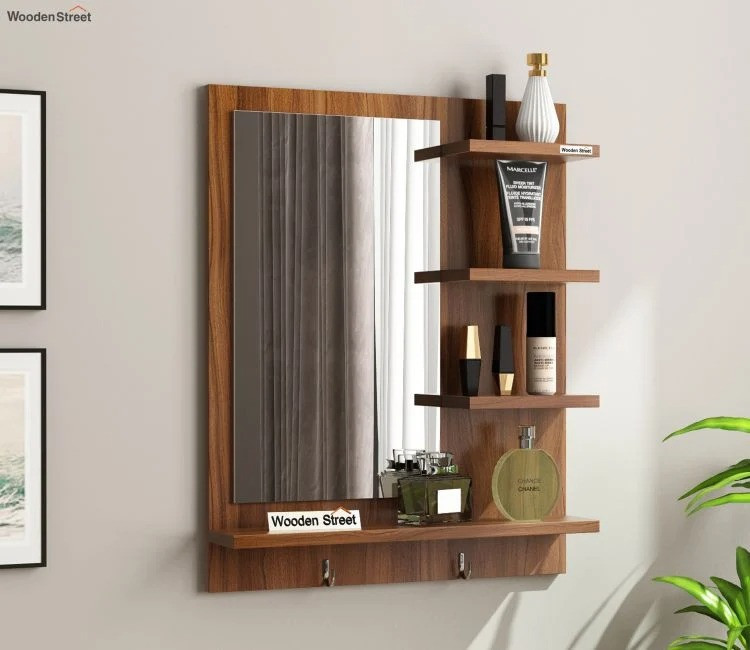views

The dressing table is more than a functional piece of furniture—it’s a symbol of self-expression, personal care, and beauty that has evolved through centuries. From opulent royal courts to contemporary city apartments, this elegant fixture has remained a mainstay in bedrooms across cultures and eras.
While today we browse dressing tables online for the latest styles and smart features, the roots of the dressing table design go far deeper. Rich in history, tradition, and transformation, the journey of the dressing table with mirror reflects shifting cultural values, changing fashion norms, and evolving concepts of personal space.
Let’s take a walk through history to explore how this iconic furniture piece has grown, adapted, and found its place in the modern world—and why so many choose to buy dressing tables online as an essential element of their home.
1. Origins in Aristocracy: Dressing Tables in Royal Europe
The earliest version of the dressing table can be traced back to 17th-century Europe, particularly in France and England. Known as "toilet tables" or "vanity tables," these early pieces were ornate and luxurious, crafted for queens, duchesses, and high-born ladies.
Elaborately carved from wood and adorned with gilded finishes, they were placed in boudoirs—private dressing rooms for aristocratic women. These tables featured mirrors, scented drawers, and compartments to hold perfumes, jewelry, and beauty tools.
During this period, grooming wasn’t just about self-care—it was a performance of status and refinement. The dressing table with mirror symbolized wealth, leisure, and sophistication.
2. The Victorian Era: Ritual and Refinement
In the 19th century, the Victorian era embraced personal grooming as a moral and social responsibility. Dressing tables became more widespread in middle-class homes and were often part of elaborate bedroom sets.
These tables featured rich woodwork, oval or tri-fold mirrors, and hidden drawers to store handwritten letters, beauty potions, and accessories. They were considered sacred spaces, especially for women, to engage in daily rituals of grooming, reading, and reflection.
The dressing table design during this period emphasized elegance, privacy, and ritual—a tradition that still influences how we view vanity spaces today.
3. Eastern Influences: Dressing Tables Across Asia
In Asian cultures, the concept of a dressing table also held spiritual and symbolic meaning. In ancient China, low tables with embedded mirrors were used for hair styling and applying makeup, often accompanied by incense and heirloom accessories. These tables symbolized grace and femininity.
In Japan, minimalist designs like the “kyōsoku” or portable makeup stands reflected the Zen philosophy of simplicity and function. The dressing table design in these regions emphasized mindfulness and subtle beauty—ideas that are reemerging in today’s minimalist interiors.
4. The 20th Century: Utility Meets Style
As the 20th century progressed, the dressing table became a mass-produced piece of bedroom furniture. Art Deco in the 1920s introduced mirrored surfaces and geometric shapes, while the 1950s saw sleek, space-saving designs with built-in lighting.
With the rise of Hollywood glamour, dressing tables took on a new identity—glamorous, star-studded, and aspirational. Women styled themselves like silver screen icons, and the dressing table with mirror became a symbol of beauty, independence, and transformation.
By mid-century, these tables were no longer exclusive to the elite—they were accessible to anyone who valued style and self-care.
5. The Modern Era: Form, Function & Self-Expression
Today, the dressing table has adapted to suit diverse lifestyles. Whether minimalist or luxurious, compact or expansive, the contemporary dressing table design focuses on blending functionality with style. The rise of urban living and small-space solutions has driven innovation in modular, wall-mounted, and multi-functional dressing units.
With the popularity of online shopping, people now buy dressing tables online that reflect their personal aesthetic and needs—be it for makeup, skincare, work, or even video calls.
Moreover, gender-neutral designs and ergonomic layouts have made dressing tables a universal fixture, no longer reserved solely for women.
6. Smart Integration: The Digital Dressing Table
In today’s tech-driven world, smart dressing tables are making headlines. Integrated LED mirrors, wireless chargers, Bluetooth speakers, and hidden tech compartments are becoming standard features.
These futuristic dressing table designs represent a seamless fusion of tradition and innovation—providing a space where personal grooming, mental wellness, and tech-savvy convenience coexist.
7. Cultural Symbolism in Modern Homes
While styles and materials have evolved, the dressing table still carries deep cultural symbolism. It represents self-care, independence, and identity. It offers a moment of stillness in an otherwise hectic day—a personal retreat where you can prepare not just your appearance, but your mindset.
In Indian homes, for instance, the dressing table with mirror often features sacred symbols, family heirlooms, or spiritual elements that connect inner and outer beauty. This holistic view of grooming continues to influence how homeowners select and style their vanities.
8. Why Dressing Tables Still Matter Today
In an age of multifunctional spaces, remote work, and fast-paced living, the dressing table is a reminder to slow down and center yourself. It offers a designated spot for:
-
Morning routines that build confidence
-
Organized storage for beauty and grooming essentials
-
Mindful reflection through the mirror ritual
-
Creative expression in styling and personalization
With so many options available, you can easily buy dressing tables online that suit your bedroom space, design taste, and daily rhythm.
Conclusion
From royal courts to minimalist studios, the dressing table has stood the test of time—adapting to cultural shifts, technological advancements, and personal needs. It has evolved from a symbol of status to a practical yet powerful expression of self-care, organization, and everyday beauty.
Whether you're searching for a vintage-style vanity or a smart tech-integrated unit, there’s a dressing table online that carries this rich history into your home. So when you next look at a dressing table with mirror, remember—it’s not just a piece of furniture. It’s a centuries-old story of elegance, empowerment, and personal ritual, still unfolding in modern bedrooms around the world.



Comments
0 comment